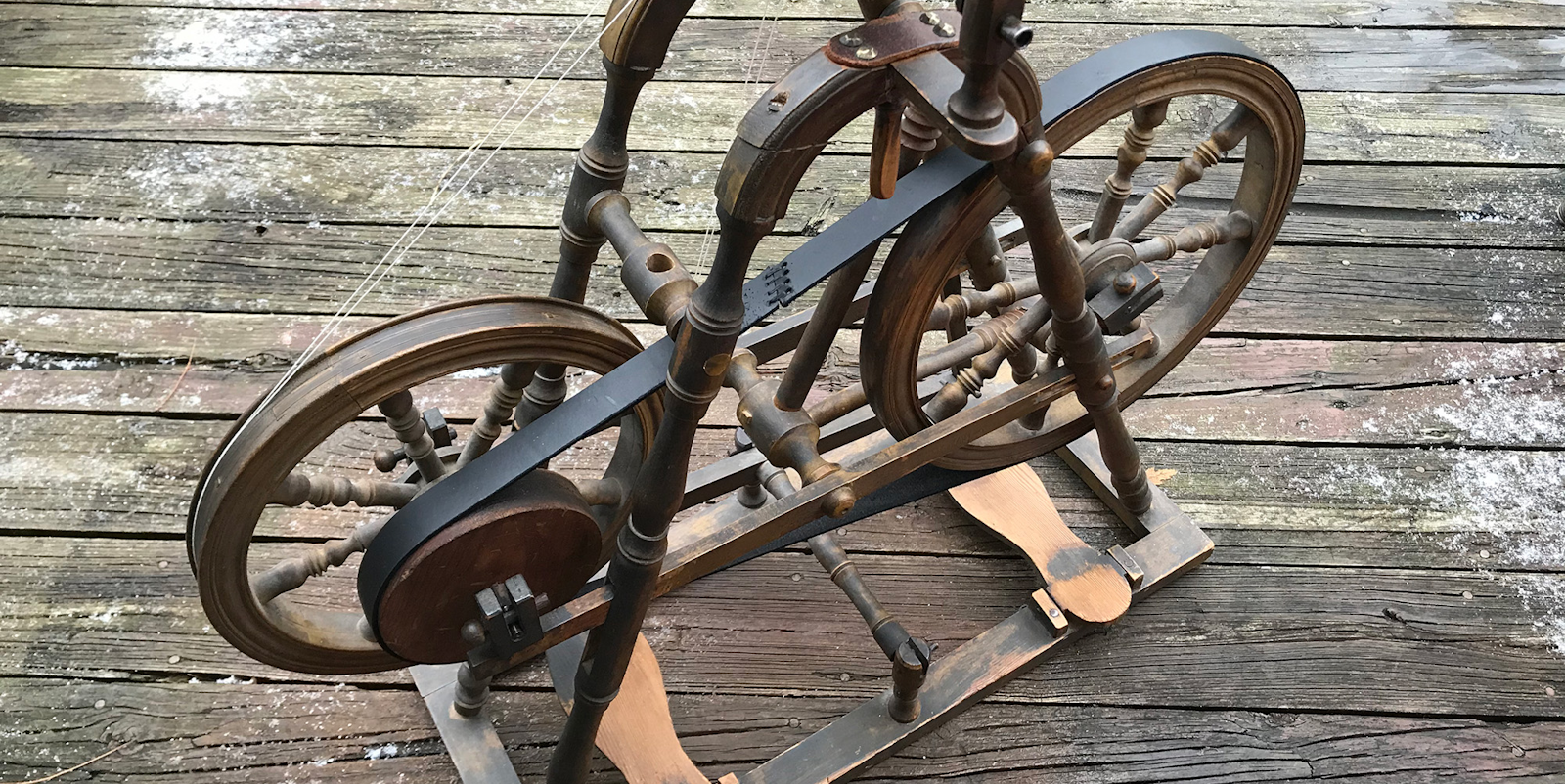Don't miss Heavenly's story about how she came to spinning through antique wheels in “A Spinner’s Path.” In the second part of the story, she explains how she fell for a unique subset of antique wheels, and what makes them special. Enjoy! —Spin Off editors
Falling for Antique Accelerator Wheels
My interest in antique wheels led me to my favorite type of spinning wheel: the accelerator wheel. This wheel is not nearly as common as other antique wheels, and it has a unique function. Multiple drive wheels connected via pulleys create more flyer speed. This means that the wheel itself can be small but still meet a spinner’s need for speed.
I currently own two accelerator wheels, and there are many variations. My Connecticut chair wheel was purchased through an online auction, and my Swedish accelerator wheel—my favorite of the two—was a flea-market find. Both wheels have some range of adjustment, but the Swedish accelerator wheel has an extraordinary range. Its design allows a spinner to make fine tension adjustments as the yarn begins filling the bobbin. These adjustments directly impact the ease of treadling and the tension on each band. For example, as the drive wheels are adjusted farther away from one another, treadling becomes increasingly difficult and the drive band tightens, allowing a stronger pull on the flyer and bobbin. In contrast, the closer the drive wheels are to one another, the more relaxed the bands are, which allows for a gentler takeup and easier treadling. Any adjustments within these parameters can vary based on drive-band materials and the spinner’s preference.
My Connecticut chair wheel does not compare to the Swedish wheel in range of motion, but it is more compact in size. The “chair” frame makes it easy to transport as it has a small footprint, yet it is a bit heavy. It has two ratios, 17:1 and 18:1, and my research suggests that it was made in the early 1800s.
 Connecticut chair wheel. Photo by Lauren Bashore
Connecticut chair wheel. Photo by Lauren Bashore
The Swedish accelerator wheel has ratios of 18.5:1 and 19.55:1, and it has a larger range of adjustment and position. The rectangular base and unique A-frame design make it easy to transport. However, because the flyer assembly is positioned on top of the wheel, it needs to be disassembled for travel. On the other hand, the wheel is very lightweight compared to my chair wheel. The Swedish accelerator is believed to have been made between the 1830s and 1860s, and similar accelerator wheels can be spotted in museums. My wheel most closely resembles accelerator wheels identified as being from Sweden’s Uppsala region.
 Heavenly’s Swedish accelerator wheel has a leather drive band.
Heavenly’s Swedish accelerator wheel has a leather drive band.
How did a rare Swedish spinning wheel make its way to the suburbs of Chicago? Between 1840 and 1930, over 1.2 million Swedish people migrated to the United States. Chicago had the largest Swedish community in the United States between 1880 and 1920. This migration happened in stages, as people traveled by sailing vessels that took weeks to arrive, and then they made their way overland to Chicago. To think that my wheel had been carefully carried so far speaks volumes.
 Swedish accelerator wheel
Swedish accelerator wheel
Accelerator Wheels: Are Two Wheels Better Than One?
Depending on the types of yarns you prefer to spin, two “wheels” can be better than one. Why would someone consider an accelerator wheel? These unusual wheels are similar to Canadian production wheels in ratio, but they are much smaller in overall size.
Here’s how they work: When a handspinner pushes her foot down on the treadle of an accelerator wheel, the drive wheel directly connected to the treadle makes one complete rotation. This drive wheel has a drive band that is connected to a small pulley on another drive wheel, which will have rotated multiple times for every treadle. The second drive wheel has yet another drive band that is connected to a typical whorl-and-flyer assembly.
Instead of having one large diameter wheel with a small whorl, an accelerator makes up for the small drive wheel by adding a second wheel that produces extra rotations of the flyer. The smaller size means that it is easier for the spinner to transport the wheel.
Resources
- Gustafson, Anita Olson. Swedish Chicago: The Shaping of an Immigrant Community, 1880–1920. Chicago: Northern Illinois University Press, 2018.
- Heavenly is known for her collection of antique spinning wheels. Get a closer look at her collection in Restored and Antique Spinning Wheels.
- If you enjoyed this article, be sure to check out part one, A Spinner’s Path..
Adapted from an article that originally appeared in the Summer 2020 issue of Spin Off.

